English
English Curriculum Statement
Our English curriculum aims to encourage all children to read and write with enthusiasm. Our diverse curriculum is led by specific topics and matched with high quality texts to support understanding and learning.
Each year group will focus their teaching of writing on the year group writing expectations. English lessons are linked to a specific termly topic. Teachers plan lessons using high quality texts or writing stimuli, this allows the children to understand any grammatical knowledge being taught through the use of the text which they are exploring.
Writing
From Years 3 to 6 we use the principles of “The Write Stuff” by Jane Considine to ensure a whole school approach to the mechanics of writing. Texts for narrative units are carefully chosen to inspire children’s writing and to enable them to acquire a rich and varied vocabulary. Non-narrative writing is based on the current topic to give context to the writing and to re-enforce knowledge.
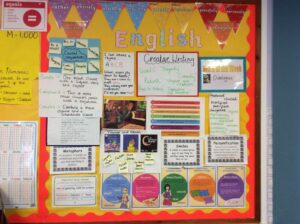 We use “Sentence Stacking” to engage children with short, intensive moments of learning that they then apply to their own writing. Each writing lesson is based on a sentence model, broken into three learning chunks:
We use “Sentence Stacking” to engage children with short, intensive moments of learning that they then apply to their own writing. Each writing lesson is based on a sentence model, broken into three learning chunks:
- Initiate: a stimulus to capture the children’s imagination, promote rich vocabulary and inspire a sentence.
- Model: the teacher models a sentence that outlines clear writing features and techniques.
- Enable: the children write their sentence, following the model.
Children are challenged to ‘Deepen the Moment’ which requires them to draw upon previously learnt skills and apply them to their writing.
Teachers use Working Walls to record essentially learning which the children can then use in their work.
Grammar and Punctuation
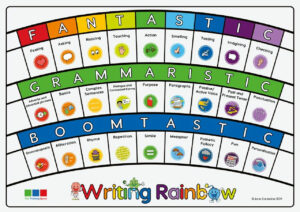
“The Write Stuff” also reinforces understanding of authorial technique and grammar through the use of:
- FANTASTICS which summarise the ideas that inspire writing.
- GRAMMARISTICS which encourage understanding of accurate structure.
- BOOMTASTICS which encourage children to use a variety of stylistic devices.
Punctuation is taught in context through the teacher model.
Where necessary grammar and punctuation is also taught explicitly before being applied in a sentence stacking lesson.
Following sentence stacking lessons, children apply their skills to an independent piece of writing using the Year group expectations.
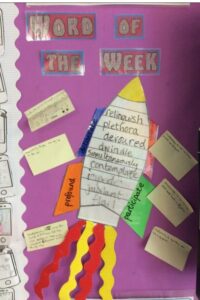
Spelling, handwriting and vocabulary
Spelling is taught both explicitly and in context according to the National Curriculum expectations.
We use Sounds and Syllables spelling programme to teach from year 3 to year 6. Sounds & Syllables is a simple but powerful spelling sequence that is used with all children from EYFS to Year 6 to spell any word. This sequence is simple to learn and is used when teaching and practising spelling, but also when attempting spellings while writing. The Sounds & Syllables sequence consists of five simple steps:
(1) say the word clearly;
(2) snip the word into syllables;
(3) say the sounds and write the spellings for each syllable in turn;
(4) target and correct any misspellings;
(5) lock in those tricky spellings by linking them to similar spellings in known words.
To support the teaching of spelling, pupils also have access to the ‘Spelling Shed’ an online platform where spellings are set by the class teacher for the children to practise at home. These spellings are then included in the weekly spelling check that consists of 5 -10 words made up of 5 words previous weeks spelling pattern and 3 – 5 statutory spelling words from that year group list.
Handwriting is taught both discretely and as an embedded skill. We use the Teach Handwriting online platform. Year 3 have 2 sessions of handwriting a week with years 4, 5 and 6 having one lesson a week to continue their skills.
At Linton Heights, we feel that it is important that schools stretch and challenge children’s minds in regards to vocabulary so that they can understand more in all areas of life. Each class has a vocabulary display that is built up of interesting language found in texts that the class has read and shared together. The adults in the classroom then encourage the children to find the meaning, synonyms and antonyms of the word. Pupils are then reminded and supported to use these words within their writing.
Reading and Phonics at Linton Heights
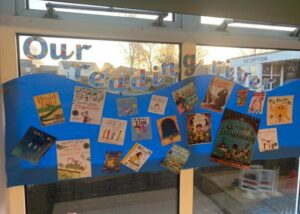 At Linton Heights we strive to ensure that children become confident readers by systematically teaching them a range of strategies that will enable them to read fluently and with good understanding. In becoming confident readers, children will be able to access information to support their development in all curriculum areas and develop an enjoyment of reading that will enrich their lives. Where children need continued or extra support with their phonic understanding, stage-appropriate texts are chosen from the school’s fully phonetically decodable scheme. We use Phonics International, a DfE validated phonics scheme, to support the ongoing teaching of phonics for those that need further consolidation of their Key Stage 1 learning.
At Linton Heights we strive to ensure that children become confident readers by systematically teaching them a range of strategies that will enable them to read fluently and with good understanding. In becoming confident readers, children will be able to access information to support their development in all curriculum areas and develop an enjoyment of reading that will enrich their lives. Where children need continued or extra support with their phonic understanding, stage-appropriate texts are chosen from the school’s fully phonetically decodable scheme. We use Phonics International, a DfE validated phonics scheme, to support the ongoing teaching of phonics for those that need further consolidation of their Key Stage 1 learning.
Over the week, children take part in three separate 30-minute whole-class reading sessions. We use a variety of stimuli, such as films, extracts and whole texts, to inspire children, capture their imagination and promote a life long love of reading. During these sessions the children will listen to a text being read to them or have an opportunity to read aloud.
Teaching sequence:
Session 1: Class book focus with the whole class, identifying and clarifying challenging vocabulary, predicting and summarising.
Session 2 : Whole class reading activity based on year group curriculum
Session 3: Whole class reading activity based on year group curriculum
Reading Coaching: This session focuses on book discussion. The pupils can share what they have been reading whilst discussing authors and genres. Teachers lead the session by sharing what they have been reading and modelling to the pupils how and why they chose a particular book.
As well as a whole-class reading session, some children can read in a small group with a member of support staff. Many children have the opportunity to read aloud to an adult or parent reader throughout the week. When children have secure phonetic knowledge, texts are chosen from our colour-banded scheme according to their reading age: these books are read and shared at home with parents as part of regular home learning.
Our reading culture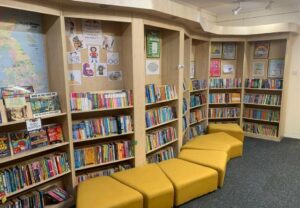
At Linton Heights we are passionate that children should have many opportunities to read for pleasure. Children are encouraged to use the school library to choose books from well-known authors and have access to a variety of genres. Our library is regularly updated with new books and the children are encouraged to request books that they would like to read. We are currently adding lots of examples of graphic novels to our library after a successful taster session in our classes.
Reading for pleasure
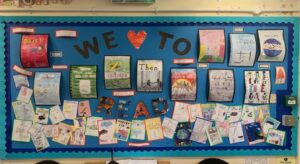 We love reading for pleasure! Children are encouraged to take up the ‘Reading Challenge’, this is a selection of 100 books to read before they are 11 3/4, these are displayed in our well-stocked library. Our librarian displays books/authors of the month to broaden the reading knowledge of the children as well as setting regular book-related competitions. Children also have amazing experiences that allow them to meet authors and talk about their love of reading with ‘an expert’. We have been lucky enough to have Ross Montgomery and Michael Rosen in recent years. This year we look forward to welcoming Luke Temple.
We love reading for pleasure! Children are encouraged to take up the ‘Reading Challenge’, this is a selection of 100 books to read before they are 11 3/4, these are displayed in our well-stocked library. Our librarian displays books/authors of the month to broaden the reading knowledge of the children as well as setting regular book-related competitions. Children also have amazing experiences that allow them to meet authors and talk about their love of reading with ‘an expert’. We have been lucky enough to have Ross Montgomery and Michael Rosen in recent years. This year we look forward to welcoming Luke Temple.
All classes have a reading area, these contain books from recommended reading list for their specific age group. These lists are shared with our parents to encourage high quality texts to read at home:
Year 3 Recommended Reading List
Year 4 Recommended Reading List
Year 5 Recommended Reading List
Year 6 Recommended Reading List
